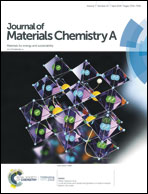Self-reductive synthesis of MXene/Na0.55Mn1.4Ti0.6O4 hybrids for high-performance symmetric lithium ion batteries†
Abstract
Increasing environmental problems and energy challenges have created an urgent demand for the development of green and efficient energy-storage systems. The search for new materials that could improve the performance of Li-ion batteries (LIBs) is one of today's most challenging tasks. Herein, a stable symmetric LIB based on the bipolar material-MXene/Na0.55Mn1.4Ti0.6O4 was developed. This bipolar hybrid material showed a typical MXene-type layered structure with high conductivity, containing two electrochemically active redox couples, namely, Mn4+/Mn3+ (3.06 V) and Mn2+/Mn (0.25 V). This MXene/Na0.55Mn2O4-based symmetric full cell exhibited the highest energy density of 393.4 W h kg−1 among all symmetric full cells reported so far, wherein it is bestowed with a high average voltage of 2.81 V and a reversible capacity of 140 mA h g−1 at a current density of 100 mA g−1. In addition, it offers a capacity retention of 79.4% after 200 cycles at a current density of 500 mA g−1. This symmetric lithium ion full battery will stimulate further research on new LIBs using the same active materials with improved safety, lower costs and a long life-span.



 Please wait while we load your content...
Please wait while we load your content...